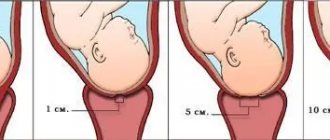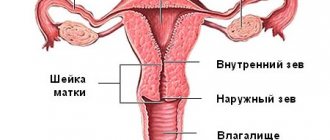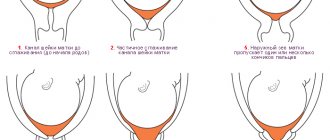How does the cervix change during pregnancy?
During the process of bearing a child, numerous changes occur in this organ, and the successful outcome of the birth will directly depend on how correctly they occur. The cervix includes the tubes that connect the vagina to the uterus, and inside is the cervical canal. During the nine months of pregnancy, the cervix should be tightly closed, which allows for reliable protection for the baby.
As the day of birth approaches, changes in the cervix are observed; they usually appear several weeks before the baby is born. Thanks to such changes, childbirth itself occurs naturally, without complications. In some cases, there is an earlier appearance of such changes. If the cervix begins to dilate before the appointed time, then this phenomenon can cause premature birth. Often, premature opening of the cervix occurs:
- With frequent miscarriages;
- If you previously had an abortion at a late or early stage;
- The cervix was injured, for example, as a result of surgery or the large size of the fetus during a previous birth.
In medical practice, there are quite often cases in which the cervix does not dilate during labor. What are the reasons for this phenomenon? In fact, there are certain reasons for the occurrence of such pathology. If the opening of the cervix does not occur, then the reasons for this phenomenon may be:
- The birth canals are poorly prepared;
- The opening process does not occur as a result of weak contractions;
- Presence of neuro-reflex disorders.
If contractions occur as expected, the uterus opens to the required size, allowing the baby to pass normally through the birth canal. If the uterus does not want to open, then first of all it is necessary to determine the cause of this phenomenon. If this can be done, the woman is prescribed appropriate therapy. At the same time, it is also necessary to understand that independent stimulation in this case is prohibited, since it can take time for the baby.
Complications
When the cervix has not opened, complications may arise in the postpartum period. You should familiarize yourself with them in advance to be as prepared as possible.
If there is no opening, it is possible to get a rupture. Complications are also caused by the fetus being too large, rapid labor and the birth of a newborn ahead of schedule.
The deviation is manifested by light bleeding; the wound is easy to diagnose with a gynecological speculum during an internal examination of the woman in labor. The defect is corrected by suturing the damaged area, but the stitches hurt for a long time.
In the complete absence of opening and unsuccessful stimulation, a conservative method of delivery is used. The baby is removed by caesarean section. Postpartum recovery will be difficult, because fresh scars will remain inside from the incision of the uterus and abdomen. It is more difficult for a woman to care for her baby after a caesarean section.
Problems with the child's health arise. If the first stage of labor is too long, due to lack of opening, hypoxia appears in the fetus, as well as difficulty breathing after birth. As a consequence of oxygen starvation, mental deviations or defects of the nervous system appear.
Lack of dilatation of the cervix leads to pathologies. It is required to be sufficiently informed about the course of delivery in order to avoid labor anomalies.
Before childbirth, the cervix does not dilate, reasons
If, on the eve of childbirth, a woman’s cervix does not naturally dilate, this may indicate that the birth canal is not sufficiently prepared for the passage of the child.
The cause of this condition may be insufficiently active contractions or various neuro-reflex pathologies that provoke excessive contraction of the smooth muscles of the cervix.
A healthy natural birth is accompanied by dilatation of the cervix sufficient for the unhindered release of the child into the big world. If during childbirth the uterus remains closed, then the specialist delivering the baby must immediately begin all the necessary manipulations to stimulate the readiness of the reproductive organs for the upcoming birth.
However, such manipulations must be carried out exclusively under the supervision of a specialist, otherwise the life and health of the child may be endangered. Only a specialized specialist can prepare the cervix for the upcoming birth; this process is called uterine stimulation, and if it starts in a timely manner, labor, as a rule, proceeds without problems. Such manipulations are recommended to be carried out after the fortieth week of pregnancy, since during this period the child is already fully formed and ready for life outside the mother’s body, and the placenta is going through the aging stage.
Stages of cervical dilatation
Many young women expecting their first child, arriving at the maternity hospital with weak contractions, hearing from the doctor during an examination that there is no dilation yet, begin to worry and wonder why the cervix does not dilate during childbirth?
But the process of expanding the lumen is divided into 3 main stages, which are not always possible to recognize independently.
The first stage of disclosure is considered to be the initial period, sometimes called slow or latent. During this period, irregular and usually mild contractions may occur. There are usually no special sensations when the cervix dilates at this time, contractions are not painful.
The duration of the first period can vary and take from several hours to several days. You should not sit and count each contraction, concentrating your attention solely on this moment, since in this case the whole process of childbirth may seem endless. If you have mild, weak contractions, you should try to sleep, as you will soon need a lot of strength and energy.
Drug assistance is usually not required in the first period, but if the doctor sees that complications may arise, he can speed up the dilatation of the cervix to avoid possible problems.
The second period is called medium or fast, as well as the active phase of opening. At this time, contractions begin to intensify, their intensity and duration increase, and the interval between them decreases. Dilation during this period can range from 4 to 8 cm.
At this time, the following rules should be observed:
Ways to prepare the uterus for childbirth
If the gynecologist, after an examination, makes a verdict that the uterus cannot open on its own, regardless of the reasons, the woman is prescribed stimulation. Such measures are necessary so that in the future, when the child is born, no complications occur. Most often, this pathology is observed in women at 40 weeks of pregnancy, when the due date has already arrived, but labor has not yet occurred. Starting from this week of pregnancy, depletion of the placenta is observed.
How to stimulate and prepare the cervix before childbirth?
The unpreparedness of the cervix for childbirth is a fairly common problem. A woman can learn about this pathology during an examination with a doctor in the last weeks of pregnancy, and in this case, a specialist may recommend artificial stimulation to allow the cervix to open properly.
There are two ways to speed up this process: medicinal and non-medicinal.
In the first case, the introduction of various medications will help solve the problem, for example:
- Kelp sticks. Sticks made from seaweed are inserted directly into the cervical canal, as a result of which its readiness for the upcoming birth is significantly increased. This happens under the influence of two factors. Firstly, the sticks are able to actively absorb moisture and increase in size, while stretching the cervix. Secondly, kelp greatly enhances the production of uterine prostaglandin, which promotes maximum softening and expansion of the cervical canal.
- Synthetic prostaglandin. This drug is available in the form of a gel or suppositories. To prepare the uterus for the upcoming birth, prostaglandin is injected into the cervical canal, which allows the maximum effect to be achieved within a few hours.
- Amniotomy is an artificial opening of the membranes of the fetal bladder. This manipulation must be carried out according to strict indications and exclusively by a medical specialist. This procedure provokes an increase in labor and contractile activity of the uterus, which can significantly accelerate the opening of its cervix.
- Injecting oxytocin intravenously or taking this drug orally. It should be borne in mind that such manipulation provokes increased pain during childbirth.
As for non-drug methods of stimulation, they can be done even at home, after consulting with a specialist. Such manipulations include:
- cleansing enema. Active cleansing of the intestines increases the contractile activity of the uterus, resulting in the opening of its cervix. In addition, thanks to the enema, the mucous plug is released, which is a sign that the uterus is ready for childbirth. However, it should be noted that this manipulation is indicated only for those women who have already experienced PDD and the child is ready to enter the big world;
- sexual intercourse Sex is one of the most effective ways to stimulate labor. First of all, sexual release can lead to active contraction of the uterus and increased blood flow to it. In addition, male sperm is a source of large amounts of prostaglandins, which soften the cervix and prepare it for childbirth. A contraindication to the use of this method is a detached mucus plug, because in this case there is no barrier to the penetration of infections into the amniotic sac;
- active physical activity. Anyone who has chosen this method of preparing the uterus for the upcoming birth is advised to pay attention to long walks, swimming, walking up stairs or cleaning. In addition, your doctor may recommend various physical exercises specifically designed to stimulate labor. However, such physical activity is prohibited in case of high blood pressure, placenta previa or late toxicosis;
- drinking strong tea, hot chocolate or a decoction of raspberry leaves. These drinks also stimulate the onset of uterine contractions, thereby speeding up the labor process.
Today, there are many known methods to speed up the dilatation of the cervix, but it is recommended to use them only under the supervision of a specialized specialist, which will avoid various problems during childbirth and preserve the health of both mother and baby.
Possible problems
From about 37 weeks, a woman’s body begins to actively prepare for the upcoming birth. Many pregnant women by this time, experiencing fear of the upcoming event, fall into panic.
Stress, nervous tension, and insufficient psychological readiness often lead to the fact that the production of hormones necessary for the beginning of the opening is inhibited, which is why the body is forced to delay the date of birth.
Even more interesting:
Apple cider vinegar for warts
Ovaries during menstruation
Many women wonder: what to do if the cervix does not open? First of all, don't be nervous. Secondly, you need to listen to the doctor and follow all his recommendations.
Often, cervical dilatation does not occur with severe polyhydramnios or oligohydramnios.
- With polyhydramnios, the uterus stretches too much, which significantly reduces its natural contractility and leads to weakness in labor as a whole.
- With oligohydramnios, the amniotic sac cannot exert the necessary pressure on the cervix for its proper full dilatation, and this also causes weakness in labor.
Also, problems with disclosure also occur in women over 35 years of age. In this case, difficulties are associated with a decrease in the elasticity of the tissues of the cervix and vagina.
In addition, difficulties during childbirth due to the fact that the cervix does not open often occur in women with various diseases of the endocrine system, for example, obesity or diabetes, as well as diseases of the genitals.
It often happens that when visiting a doctor before giving birth, a woman hears that the cervix is not yet ready and does not have the required maturity, although the day of birth is already close. This problem is serious in cases where the pregnancy is already full term and exceeds 40 weeks, since during this period the placenta can no longer perform the necessary functions of providing the fetus with nutrition and oxygen, resulting in hypoxia.
Stimulation of labor and the onset of dilatation can be carried out using both medicinal and non-medicinal methods.
At the same time, medicinal stimulation using tablets and drugs to dilate the cervix is carried out only in a hospital setting, since such actions can cause rapid labor.
Drug stimulation may include:
- the introduction of special drugs into the cervical canal, which allows you to achieve the desired result in just a few hours;
- insertion of kelp sticks into the cervical canal. Absorbing moisture, seaweed sticks begin to swell, opening the neck mechanically in 4-5 hours. But, in addition, the rods contain endogenous prostaglandins, which stimulate the ripening of the cervix in a biochemical way;
- amniotomy is also a stimulation method and involves puncturing the amniotic sac. After this procedure, the anterior waters are released, and the baby's descending head begins to put additional pressure on the cervix, forcing it to stretch.
Non-medicinal methods include not only a cleansing enema, which smoothes the posterior uterine wall and thereby causes its contraction, but also sexual intercourse, as well as physical activity.
But you should not use such methods yourself, since the risk of other complications will be very high.
Dilatation of the cervix is the first stage of the birth of a baby, the correctness of which determines the entire birth process, its speed and the occurrence of possible complications.
You should not try to speed up labor on your own and influence the cervix to open it, if this is necessary - you need to entrust such actions to a doctor. It is important to properly tune in to childbirth emotionally and be psychologically prepared for this process, then everything will go much easier and faster.
Author: Irina Vaganova, doctor, especially for Mama66.ru
Stimulation without drugs
It is also possible to stimulate the uterus without the use of various types of medications. It is possible to carry out such actions at home, but in any case you should first consult a doctor, because in some cases complications are possible.
You can induce uterine contractions using a regular enema.
Doctors have repeatedly noticed that after this pathology occurs, the mucous plug comes out, which allows the uterus to begin to open. However, in this case, you need to know that an enema is possible only if the day of the scheduled birth has already passed.
You can stimulate the dilatation of the cervix in a natural way as a result of sex. The uterus begins to contract, and increased blood flow is observed. Sperm also contains prostaglandins, popularly called the “birth hormone.” Speaking about stimulating the dilation of the cervix without the use of medications, it is necessary to note physical activity. in this case, it is recommended to walk up the stairs, walk for a long time, and do household chores. However, this technique is prohibited if a woman has placenta previa, hypertension and gestosis.
To summarize all of the above, it should be noted that none of the described actions can be carried out on your own initiative, without prior consultation with a gynecologist. Otherwise, you can harm not only your health, but also your child. Having all the necessary information, you can prevent such an unpleasant problem as the lack of dilatation of the cervix.
Source: womanchoise.ru
Similar articles
- Cervical erosion: treatment, symptoms, causes The term “erosion” is widely used in practical life and literature for the pathological process on the vaginal part of the cervix, characterized in the initial stage by dystrophy and desquamation of squamous multilayer epithelium (ulceration, erosion) with subsequent development on ...
- Endometriosis of the uterus in women: symptoms, causes, treatment Endometriosis - what is it? Endometriosis is a pathological growth of the uterine mucosa (endometrium), leading to the formation of adhesions in the appendages and abdominal cavity. Depending on the area of distribution, experts distinguish: genital endometriosis (affects the vagina...
- Pathology of the endometrium of the uterus, causes, types and treatment Recently, many women have encountered diseases of the uterine mucosa. Pathologies of the endometrium of the uterus are observed in representatives of the fairer sex, regardless of their age, and they can lead to very negative consequences. Often…










